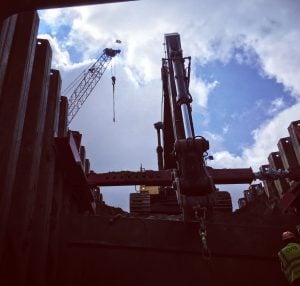An explanation of the effects that the wind has on a scaffold that is wrapped or enclosed with a tarp, shrink wrap, plastic or other cladding.
As you well know, the wind blows. Have you ever considered that instead, perhaps the wind sucks? As one construction superintendent said to a friend of mine: “Don’t tell me about the wind; I’ve been around wind all my life!” And from there, it’s easy to assume that that experience makes him an expert. And if this superintendent is an expert on wind, then I suppose we all are experts on the wind since we have the same experience. Logical conclusion perhaps, but the facts indicate otherwise, particularly with scaffolds in general and specifically with enclosed scaffolds, that is scaffolds that are wrapped with a tarp, screening or other enclosure material. As we approach another winter season where the temperature goes the wrong way from warm for many areas of North America and the winds have a tendency to blow (or is that suck?) ill will on many scaffolds, we will once again experience the disappointment of scaffolds falling due to an overzealous sucking (or is that blowing?) wind.
I’m impressed with the courageous attitude certain scaffold erectors, and users, have when challenging the wind. This personal fortitude too often, and unfortunately, is founded on a lack of understanding of the power and dynamics of the wind. My experience indicates that luck, mostly bad, is involved with many wrapped scaffolds and not courage as some may assume. Worse yet, some scaffolders just think that you cannot design for the wind, just that you’ll be lucky or unlucky, that building scaffolds is a roll of the dice. Feeling lucky today?
Believe it or not, the force of the wind can be calculated and a scaffold can actually be designed to resist the wind. To do this, an understanding of the wind speed, wind pressure, and other factors is required. And yes, the wind blows and sucks. If you don’t think so, look at a scaffold that is wrapped in plastic; in some areas the plastic is pushing into the scaffold and in other areas the plastic is pulling away from the scaffold.
It appears that there is some confusion by the ill-informed that the various scaffold standards regarding tying supported scaffolds to an existing structure are instructions on how to adequately design and erect a scaffold so it doesn’t fall over in the wind. For example, a common requirement specifies that supported scaffolds be tied to a structure at intervals not to exceed 26 feet vertically and 30 feet horizontally. This is a minimum requirement and it is not based on the wind but rather on the stability of the scaffold. Therefore, to assume that tying the scaffold into a building every 30 feet horizontally and every 26 feet vertically is adequate is just plain dangerous unless your scaffold and the tie can hold the wind load. For most areas of North America the load on the tie can be well above 15,000 pounds at that spacing. Your #9 wire and 16 penny nail just isn’t going to hack it! But wait, can the load actually be that high? Yes it can. Here are a few facts to consider:
- The design wind speed for most areas of North America is 90 mph;
- You only need one gust at 90 mph to bring down the scaffold;
- To determine the load on a scaffold tie, the wind speed must be converted to pounds;
- Formulae actually exist for doing this conversion;
- The American Society of Civil Engineers (ASCE) has developed a procedure for wind design;
- The higher you go on the scaffold, the stronger the wind becomes;
- The shape of the scaffold has an effect on the wind pressure;
- The shape of the structure has an effect on the wind pressure;
- Where the scaffold is relative to adjacent structures has an effect on the wind pressure;
- Geography affects the wind pressure;
- Time of year affects the wind pressure design;
- Project duration affect the wind pressure design;
- Scaffold importance affects the wind pressure design;
- The pressure on the enclosure at the corner of a scaffold can be twice what it is in the middle of the scaffold;
- The pressure on the enclosure at the top of the scaffold can be three times what is in the middle of the scaffold (This would mean the upper corner is the most vulnerable);
- Fully enclosed versus partially enclosed scaffolds have an effect on wind pressure and tie loads;
- Feeling lucky has no positive effect on the wind pressure.
Christopher Columbus, and others before and after him, figured out the advantages and disadvantages of the strength of the wind. It’s not necessary for you to experiment—North America has already been “discovered.” If you want to get a general, and I mean general, idea of how much force a wind has, do this: Multiply the wind speed, in miles per hour, times itself, (in other words, square the wind speed) and then times 0.00512. Take this answer and multiply it times 780. This will give you the force, in pounds, on a tie spaced at 26 feet by 30 feet. Pretty exciting, huh? As an example, take a wind speed of 45 mph. The tie load = 45 x 45 x 0.00512 x 780 = 8,087 pounds. Double that for the ends of the scaffold and triple it for the ties at the roof line. This is serious stuff: get a qualified person to design the enclosed scaffold for you unless, of course, you’re feelin’ lucky. And finally, remember that if the wind is blowing out of the northeast, it’s sucking from the southwest.













